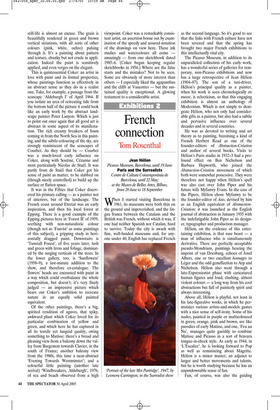French connection
Tom Rosenthal
Jean Hélion Picasso Museum, Barcelona, until 19 June Paris and the Surrealists Centre de Cultura Contemporània de Barcelona, until 22 May; at the Museo de Bellas Artes, Bilbao, from 20 June to 18 September When I started visiting Barcelona in 1961, its museums were both thin on the ground and impoverished, and the lingua franca between the Catalans and the British was French, without which it was, if one had neither Spanish nor Catalan, hard to survive. Today the city is awash with fine, well-funded museums and, for anyone under 40, English has replaced French as the second language. So it’s good to see that the links with French culture have not been severed and that the spring has brought two major French exhibitions to this intellectually vital city.
The Picasso Museum, in addition to its unparalleled collection of his early work, has a wonderful series of galleries for temporary, non-Picasso exhibitions and now has a large retrospective of Jean Hélion (1904–87). The son of a taxi-driver, Hélion’s principal quality as a painter, when his work is seen chronologically en masse, is eclecticism, so that this engaging exhibition is almost an anthology of Modernism. Which is not simply to denigrate Hélion, who not only had considerable gifts as a painter, but also had a subtle and pervasive influence over several decades and in several countries.
He was as devoted to writing and art theory as to painting, becoming a kind of French Herbert Read as one of the founder-editors of Abstraction-Création and author of several books. Visits to Hélion’s Paris studio in 1932–3 had a profound effect on Ben Nicholson and Barbara Hepworth, who joined the Abstraction-Création movement of which both were somewhat possessive. They were therefore not happy when Hélion’s spell was also cast over John Piper and his future wife Myfanwy Evans. In the case of the Pipers, Hélion chose Myfanwy to be the founder-editor of Axis, devised by him as an English equivalent of AbstractionCréation; it was launched as the English journal of abstraction in January 1935 with the indefatigable John Piper as its designer, typographer and production manager.
Hélion, on the evidence of this entertaining exhibition, is that rare beast — a man of influence who is simultaneously derivative. There are perfectly acceptable pseudo-Mondrians, paintings bearing the imprint of van Doesburg, echoes of Josef Albers, one or two excellent homages to Léger and the odd genuflection to Arp and Nicholson. Hélion also went through a late-Expressionist phase with caricatured human figures and loud, clashing, almost violent colours — a long way from his cool abstractions but full of painterly spirit and always interesting.
Above all, Hélion is playful, not least in his late-figurative works, in which he permutates various artists-and-models games with a nice sense of self-irony. Some of his nudes, painted in purple or multicoloured in green, orange, pink and brown, are like parodies of early Matisse, and one, ‘Feu au Nu’, manages quite garishly to combine Matisse and Picasso in a sort of bravura tongue-in-cheek style. As early as 1944, in ‘L’Escalier’, he is looking forward to Pop as well as reminiscing about Magritte. Hélion is a minor master, an adjunct to larger and better movements and talents, but he is worth studying because he has an unputdownable sense of fun.
Fun, of course, was also the guiding principle of the Surrealists, immaculately displayed at the CCCB, which is a brilliantly organised, part cultural organisation, part conference centre just off the Ramblas, with a fine, sinuously winding gallery perfectly suited to showing this substantial selection of, on the whole, small but always fascinating Surrealist works. Although its focus is on Paris and the Surrealists, there are plenty of paintings by the two dominant Catalans, Dalí and Miró. But there are also fine representative paintings and photographs by Roland Penrose and Lee Miller, and a strong selection of photographs and objects by Man Ray, including his metronome with a large human eye painted on to its swinging arm. Hans Bellmer is represented by some typically sadistic, and off-putting, tormented female bodies, and Georges Hugnet by some witty collages. But, as always when you see the Surrealists en masse, the pervasive impression is of fun, games and erotic dreams. Meret Oppenheim’s fur fetishes, Clovis Trouille’s pin-up nun, smoking in full make-up, with skirt raised to show off her red-stockinged legs, Paul Eluard’s woman semi-nude, the naked portion being cruciform in shape, are all original, witty and thought-provoking. All the big names are well represented, including such masterpieces as Max Ernst’s ‘The Hunter’, Magritte’s cover for Minotaure issue no. ten, Dorothea Tanning’s ‘Little Nocturnal Serenade’, and the glorious ‘Portrait of the late Mrs Partridge’ by Leonora Carrington, as well as works by lesserknown artists such as Toyen, whose 1930 ‘Girl Dreaming’ shows a nude on a divan surrounded by sperm-like balloons, each containing an erect penis, the ultimate paradigm of Surrealist imagery.





















































 Previous page
Previous page